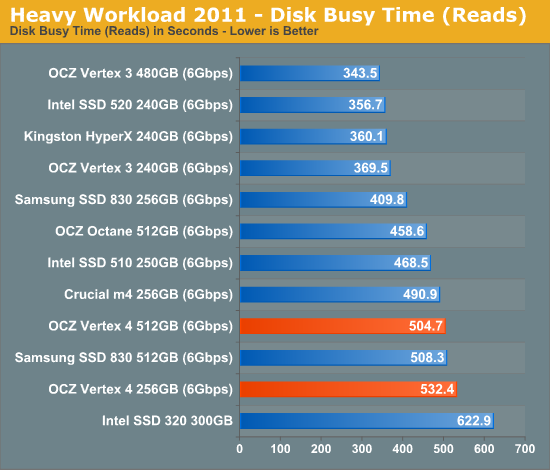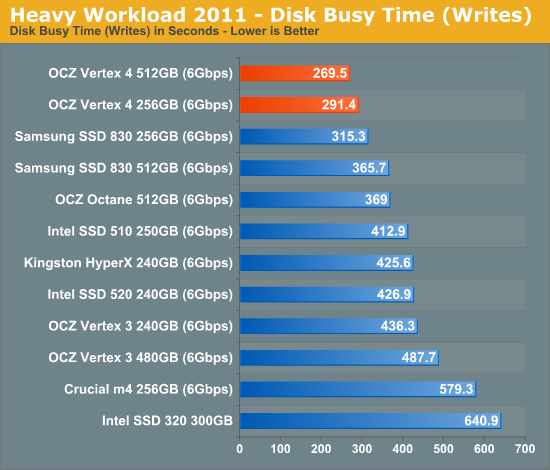OCZ Vertex 4 Review (256GB, 512GB)
by Anand Lal Shimpi on April 4, 2012 9:00 AM ESTAnandTech Storage Bench 2011
Two years ago we introduced our AnandTech Storage Bench, a suite of benchmarks that took traces of real OS/application usage and played them back in a repeatable manner. I assembled the traces myself out of frustration with the majority of what we have today in terms of SSD benchmarks.
Although the AnandTech Storage Bench tests did a good job of characterizing SSD performance, they weren't stressful enough. All of the tests performed less than 10GB of reads/writes and typically involved only 4GB of writes specifically. That's not even enough exceed the spare area on most SSDs. Most canned SSD benchmarks don't even come close to writing a single gigabyte of data, but that doesn't mean that simply writing 4GB is acceptable.
Originally I kept the benchmarks short enough that they wouldn't be a burden to run (~30 minutes) but long enough that they were representative of what a power user might do with their system.
Not too long ago I tweeted that I had created what I referred to as the Mother of All SSD Benchmarks (MOASB). Rather than only writing 4GB of data to the drive, this benchmark writes 106.32GB. It's the load you'd put on a drive after nearly two weeks of constant usage. And it takes a *long* time to run.
1) The MOASB, officially called AnandTech Storage Bench 2011 - Heavy Workload, mainly focuses on the times when your I/O activity is the highest. There is a lot of downloading and application installing that happens during the course of this test. My thinking was that it's during application installs, file copies, downloading and multitasking with all of this that you can really notice performance differences between drives.
2) I tried to cover as many bases as possible with the software I incorporated into this test. There's a lot of photo editing in Photoshop, HTML editing in Dreamweaver, web browsing, game playing/level loading (Starcraft II & WoW are both a part of the test) as well as general use stuff (application installing, virus scanning). I included a large amount of email downloading, document creation and editing as well. To top it all off I even use Visual Studio 2008 to build Chromium during the test.
The test has 2,168,893 read operations and 1,783,447 write operations. The IO breakdown is as follows:
| AnandTech Storage Bench 2011 - Heavy Workload IO Breakdown | ||||
| IO Size | % of Total | |||
| 4KB | 28% | |||
| 16KB | 10% | |||
| 32KB | 10% | |||
| 64KB | 4% | |||
Only 42% of all operations are sequential, the rest range from pseudo to fully random (with most falling in the pseudo-random category). Average queue depth is 4.625 IOs, with 59% of operations taking place in an IO queue of 1.
Many of you have asked for a better way to really characterize performance. Simply looking at IOPS doesn't really say much. As a result I'm going to be presenting Storage Bench 2011 data in a slightly different way. We'll have performance represented as Average MB/s, with higher numbers being better. At the same time I'll be reporting how long the SSD was busy while running this test. These disk busy graphs will show you exactly how much time was shaved off by using a faster drive vs. a slower one during the course of this test. Finally, I will also break out performance into reads, writes and combined. The reason I do this is to help balance out the fact that this test is unusually write intensive, which can often hide the benefits of a drive with good read performance.
There's also a new light workload for 2011. This is a far more reasonable, typical every day use case benchmark. Lots of web browsing, photo editing (but with a greater focus on photo consumption), video playback as well as some application installs and gaming. This test isn't nearly as write intensive as the MOASB but it's still multiple times more write intensive than what we were running in 2010.
As always I don't believe that these two benchmarks alone are enough to characterize the performance of a drive, but hopefully along with the rest of our tests they will help provide a better idea.
The testbed for Storage Bench 2011 has changed as well. We're now using a Sandy Bridge platform with full 6Gbps support for these tests.
AnandTech Storage Bench 2011 - Heavy Workload
We'll start out by looking at average data rate throughout our heavy workload test:
The overall score here is in-line with the SF-2281 solutions and OCZ's Octane. Our heavy workload is fairly write intensive, so I honestly expected the Vertex 4 to top the charts. Looking at the read/write breakdown explains why though:

Here we see the Vertex 4's poor low queue-depth sequential read performance rearing its head once more. Look at the sequential write speed and you'll see where OCZ makes up for its shortcomings however. The Vertex 4 writes quicker than any drive we've tested.

It's a tough tradeoff to come to terms with. The Vertex 4 delivers performance when it matters the most, but typically you want the absolute best performance regardless of workload. All of this may become moot if OCZ is able to address the situation with a firmware update in the coming weeks like it promised, but for buyers today it is something you have to think about.
The next three charts just represent the same data, but in a different manner. Instead of looking at average data rate, we're looking at how long the disk was busy for during this entire test. Note that disk busy time excludes any and all idles, this is just how long the SSD was busy doing something:














127 Comments
View All Comments
gigahertz20 - Friday, June 29, 2012 - link
Yes, I would like to see if the newer firmware has fixed this as well as OCZ promised. I wish they would create an update for this review.yj100 - Monday, July 9, 2012 - link
I got a Vertex 4 512gb a week ago for my MacBook Pro and after 2 days it crashed. Only a gray screen with a spinning wheel would come up when trying to boot.Apparently this is common as OCZ have a forum thread dedicated to this. Apparently they have a firmware fix but it didn't help me.
I have a 256gb Vertex 4 for about a couple of months with no problems. For 512gb I'm going to stay away from the Vertex 4.
Zarathustra[h] - Wednesday, July 25, 2012 - link
As some other sites have tested, it seems like the Vertex 4 is a completely different drive with the newer 1.4 firmware, and 1.5 added even more performance.Has Anandtech considered revisiting this drive with a later firmware? I have much more faith in Anandtechs reviews on SSD's than others and would love to see this drive tested with the latest firmware.
Zoeff - Sunday, July 29, 2012 - link
I second this.The heavy/light storage bench is unique to Anandtech and feels much more representative of actual usage.
Salv0 - Wednesday, August 1, 2012 - link
+1Retest with the latest fw will be great!
teefatt - Monday, September 3, 2012 - link
To potential OCZ SSD buyers,I posted the above matters to OCZ forum and got no solution from them after many email in and out in a week time. They want me to write an email to HP for help. They even deleted my reply and make the post like I did not reply their request or reply their mail. Furthermore, they blocked my post. They wanted me to send them a personal email instead of on the public forum.
They moved my post to ForumOCZ Support ForumCompliments, Complaints, & SuggestionsVertex 4 512GB BSOD in RAID 0 setup.
or
http://www.ocztechnologyforum.com/forum/showthread...
That's why I totally agree with the post here on the first page:
"It's still a drive from OCZ, a company that has repeatedly and blatantly used its customer base as unpaid beta testers, and lambasted them when they dared to complain about it. No thank you. The fastest drive in the world is of no use to me if it's causing my computer to BSOD constantly. I'll be spending my money and that of my many clients on drives with proven track records for reliability and excellent customer service, both sadly lacking in OCZ products."
I will walk away from this OCZ unreliable SSD. Luckily I am able to return the drives and asked for refund instead of following their steps to do the beta tester in a week time.
Think twice before you buy it.
Thanks you.
vwrafi - Saturday, September 29, 2012 - link
Hi. When the drive goes into the GC mode ( standard mode ), does it mean that the drive will start to read and write its internal data ? If so, does it mean that the write lifetime of the cells will reduce ( write lifetime of the disk will be reduced every time it reorganize itself ) ? And if so, can we switch off this or install firmware that do not shorten the write lifetime of the disk ?